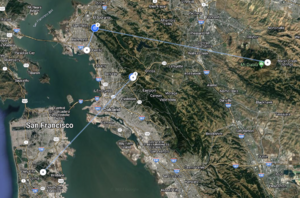Bay Area Backbone: Difference between revisions
m (→Active) |
m (→Proposed) |
||
| Line 52: | Line 52: | ||
* [[San Carlos]] |
* [[San Carlos]] |
||
** [[Sunol Ridge]] |
** [[Sunol Ridge]] |
||
| + | ** [[Mount Allison]] |
||
* [[Sunol Ridge]] |
* [[Sunol Ridge]] |
||
** [[San Carlos]] |
** [[San Carlos]] |
||
Revision as of 21:09, 5 October 2022
The Bay Area Backbone Project is building solid, fast, links between major high sites in the Bay Area, which in turn supports a more stable mesh network. Backbone sites are permanent locations, not dependent on amateur radio operators' homes or difficult to access places.
Status
The current health of the backbone is monitored here (internet)
Management VLANs
Each site manages its devices on a unique VLAN to isolate them from all other sites (the management VLAN is not passed across any links).
- 3 - ORCA and Fish Ranch (need to improve this)
- 121 - Mount Diablo
- 122 - CCCC
- 1001 - San Carlos
- 1002 - Black Mountain
- 1003 - San Pedro
- None - Wolfback
Backbone Links
Active
Planned
Proposed
Backbone Network Structure
The current set of backbone links operate simply by switching VLAN2 (DtD) between all radios. This essentially makes all AREDN nodes at each site look like they're on one ethernet segment. While sufficient for now, this is not ideal as the network increase in size.
A recent addition to the AREDN code (PR #514) allows additional VLANs or other network interfaces to be added to the AREDN/OLSR L3 routing layer. This enables the use of external routers and switches when building the backbone network without additional requirements on the AREDN nodes themselves.
Possible Network Organizations
Point-to-point VLANs
One simple option is to create individual VLANs between pair of backbone radios. These VLANs are then added to an AREDN node (perhaps an hAP or similar) at each site. Topology and routing uses the current OLSR mechanism. The has the upside of being simple to implement and better than one giant shared VLAN. The downside is that this doesnt solve the routing problem for non-AREDN user of the backbone.
Fully Routed
...
